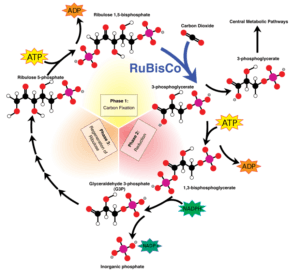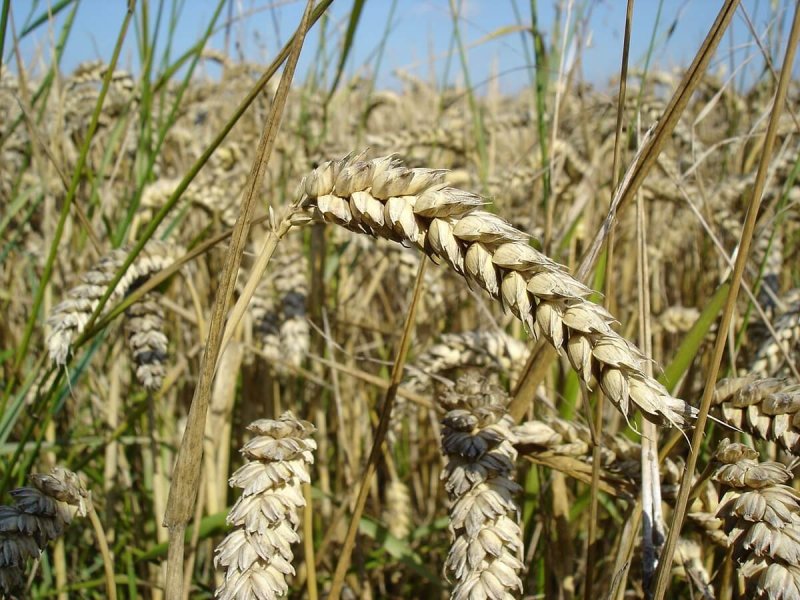Like our friend Goldilocks, of three bear’s fame, plants like their sustenance just so. Under optimal conditions, photosynthesis is a remarkably efficient process, converting carbon dioxide and light into glucose (a sugar) and oxygen. Glucose can be metabolised to make a molecule called ATP (Adenosine TriPhosphate), which functions like a cellular battery, energizing the various ins and outs of plant physiology.
Carbon dioxide is removed from the atmosphere. The glucose and its various derivatives taste good when we eat the plants. The oxygen does its bit to keep us all alive. Photosynthesis is a fantastically good deal.
Surprisingly though, photosynthesis is inherently inefficient. This is a problem because an increasing global population, coupled with decreasing land availability means that we really need to start turning the screw on agricultural productivity (don’t make me come at you with the UNFAO stats).
Plant breeders have been unable to make gains in photosynthetic efficiency, because of insufficient natural genetic variation. This is where the vast possibilities of genetic engineering come into play.
Balancing photosynthetic responses to light intensity comes with a cost
Plant leaves operate in an extremely dynamic environment. Light intensity rises and falls regularly as a by-product of canopy movement and environmental flux (cloud cover/ mist / position of the earth relative to the sun etc).
When plant leaves are exposed to more light than they can use, they need to protect themselves from the biochemical fallout that comes with uncontrolled energetic input. If left unchecked, the plant leaves would bleach white and become photosynthetically inert — they may be useless to the plant for quite some time. In order to protect the leaf, the photosynthetic pathway is altered such that light is converted to heat, which can then dissipate safely from the leaf surface. This process is termed photoprotection.
Specifically, a mechanism known as nonphotochemical quenching of chlorophyll fluorescence (NPQ) facilitates this energetic venting process. The system has its flaws though. It activates quicker than it deactivates, which means that there is an efficiency cost when exiting NPQ due to the lagging response time.
In fact, the delay between switching the NPQ process off, and returning to peak photosynthesis is exacerbated with repetition of the activation / deactivation cycle.
Huge, seemingly intractable modelling problems, such as that presented by the complexity of photosynthesis and associate variables, tend to get a lot simpler when they are mashed into 1s and 0s and left to simmer overnight in the silicon belly of a computer cluster. Taking sources of environmental and biological variability into account, computational approaches estimate that this biochemical transition bears an efficiency loss of 7.5 percent to 30 percent. This has obvious growth and yield-limiting implications.
Steve and his research group managed to speed the rate of transition from NPQ protective to photosynthetically productive by increasing the abundance of genes required to recharge the system — genetic engineering! They made more copies of the genes available to the photosynthetic leaf cells, and that correspondingly increased the amount of protein and enhanced the speed of NPQ exit. This translated into a handsome productivity gain of 15 percent (Kromdijk et al., 2016).
I’ve seen images of the field trial plants at conferences, and I can tell you that the difference is striking. Steve and his team of genetic engineers have effectively re-tuned the nuclear engine of the plant for higher performance, just as a mechanical engineer would for a high-spec racing car.
That isn’t the end of the story though.
There is also a problem from the other side of this energetic balance — the uplift in photosynthetic activity from light limiting shade to full sunlight. Steve’s latest research paper speaks to this (Taylor and Long, 2017). By his own estimation, optimising this aspect of photosynthesis could yield similar gains in efficiency to that found on optimising the NPQ transition. Collectively, those gains could be transformative in terms of sustainable intensification of agriculture.
Potential fixes to enhance the shade to sun transition
Decreasing the lag to peak photosynthesis on moving from shade to full sunlight could be achieved by increasing the amount of rubisco activase, which is a rate-limiting enzyme involved in kick-starting another enzyme called RuBisCo — the key player in carbon dioxide utilisation and photosynthetic activity. This approach has been demonstrated previously in rice (Yamori et al., 2012).

Alternatively, genome editing (e.g. CRISPR-cas9) approaches could be used to modify the amino acid composition of rubisco activase. This might be effective as there is a clear link between the amino acid composition of rubisco activasein other plant species, and the activity of the enzyme (Carmo-Silva et al., 2013). Engineering a more efficient rubisco activase response, either by increasing the amount of it (over-expressing by inserting extra gene copies), or modifying the native enzyme to work more efficiently, represent potentially high value targets for crop improvement strategies.
I’m looking forward to catching up with Steve at the Gates Foundation Grand Challenges conference in Washington next month, and learning about their progress. For those that want more information on the topics explored here, check out the lecture and references below.
References
Kromdijk, Glowacka, Leonelli, Gabilly, Iwai, Niyogi, Long. 2016. Improving photosynthesis and crop productivity by accelerating recovery from photoprotection. Science 354, 857–861. doi:10.1126/science.aai8878
Taylor and Long. Slow induction of photosynthesis on shade to sun transitions in wheat may cost at least 21% of productivity. Philos Trans R Soc Lond B Biol Sci.2017 Sep 26; 372(1730): 20160543. Published online 2017 Aug 14. doi: 10.1098/rstb.2016.0543
Yamori, Masumoto, Fukayama, Makino. 2012. Rubisco activase is a key regulator of non-steady-state photosynthesis at any leaf temperature and, to a lesser extent, of steady-state photosynthesis at high temperature. Plant J. 71, 871–880. (doi:10.1111/j.1365–313X.2012.05041.x)
Carmo-Silva, Salvucci. 2013. The regulatory properties of Rubisco activase differ among species and affect photosynthetic induction during light transitions. Plant Physiol. 161, 1645–1655. (doi:10.1104/pp.112.213348)
Johnathan Dalzell is a lecturer in molecular biology and parasitology at Queens University Belfast. His research group is focused on plant-parasite interactions, and is developing novel sources of genetically engineered resistance in plantain with the Bill and Melinda Gates Foundation. Follow him on Twitter @jjdalzell
This article was originally published on his blog as The transition from shade to sunlight can reduce wheat productivity by 21% — Genetic engineering can help with that! and has been published here with permission.































